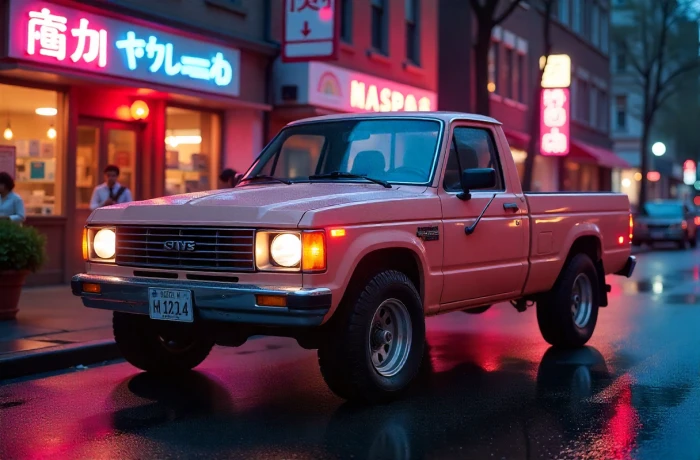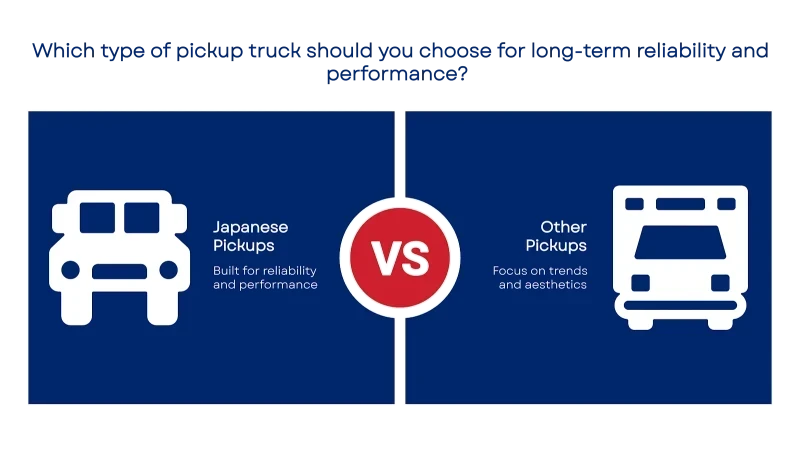Why Japanese Pickup Trucks Still Lead the Way in 2025
Japanese pickup trucks are the best choices for 2025 if you want long-lasting power, innovative features, and real-world toughness in one vehicle. They’re built like a cast-iron skillet; nothing fancy, but they always get the job done. Trends come and go, but some things, like a good pickup, always work.
Think about the friend who’s always there when things go sideways. That’s what Japanese pickups are like. They’re the kind of trucks people trust to haul heavy loads, go off-road in the heat, or start every time in cold weather. They aren’t made to impress at a glance. They’re made to stick around.
What You’ll Learn
In this blog, you’ll find:
Why Japanese pickup trucks still lead in reliability, value, and performance in 2025
What design changes and technology upgrades define the newest models
Which trucks fit different needs, from budget to off-road to family-friendly
Overview: Choosing the Best 2025 Japanese Pickup Truck
In 2025, Japanese pickup trucks stand out for their balance of power, durability, and innovative features. Whether you're looking for an off-road beast, a work truck, or something easy to drive in the city, there’s a model built for it. The right pick depends on how you plan to use it and what matters most: budget, towing power, or comfort.
Here’s a more detailed breakdown:
Off-Road and Extreme Terrain Specialists
Toyota Land Cruiser Pickup: Offers diesel and V6/V8 options, solid axles, and high clearance.
Toyota Hilux: Reinforced frame and advanced traction for all-terrain driving.
Trucks for Everyday Comfort
Honda Ridgeline: Unibody design for smooth handling and an in-bed trunk for extra storage.
Nissan Frontier: Comfortable interior, updated tech, and enough muscle for weekend hauling.
Full-Size Power Options
Toyota Tundra: Seats up to five, powerful engine choices, and high resale ratings.
A Truck That Doesn’t Quit
It’s common around here to see an old Japanese pickup still running strong. They may be scratched, dented, and dusty, but they keep starting every morning and hauling what needs to be hauled.
Some folks keep theirs for ten or fifteen years, then sell it to someone else who keeps it going even longer. That’s how these trucks earned their reputation — not through looks or hype, but through reliability you can count on.
Even now, in 2025, they’re built with that same dependable spirit, while adding features that make the ride more comfortable and practical. For anyone buying their first truck or replacing one that has served its time, the goal is still the same: something that works when you need it to.
Best Japanese Pickup Trucks: Features, Strengths, and Standouts for 2025
Japanese pickups stand out for blending practical design with real-world toughness. Here are the standout models you’ll see in 2025, each one designed to handle specific needs.
Quick Feature Comparison of 2025 Japanese Pickup Trucks
Toyota Hilux – The All-Around Champion
For years, it’s been the standard by which other trucks are measured.
Known worldwide for its toughness and reliability.
It comes with powerful diesel engine options and improved off-road tech.
Available in single and double cab layouts, with trims that include touchscreens, safety systems, and digital displays.
Handles rough trails and city traffic equally well.
Nissan Frontier – The Balanced Performer
With its upgraded comfort and off-road chops, the Frontier hits a sweet spot. It’s ideal for individuals who require a diverse range of options.
Smooth ride quality thanks to rear coil spring suspension.
Combines off-road power with comfort for everyday driving.
The 2025 update includes upgraded safety systems and a tech-focused interior.
It's a great choice if you want both performance and convenience.
Toyota Land Cruiser Pickup – The Off-Road Specialist
Toyota Land Cruiser Pickup is a truck built for extreme use. If you plan to go far from paved roads, the Land Cruiser Pickup is made for you.
Built for harsh terrain like desert, rock, and dirt roads.
Solid axles, high clearance, and options for V6, V8, or turbo diesel engines.
Features electric winches, LED headlights, and minimalist but durable interiors.
Used by serious off-roaders and expedition teams.
Honda Ridgeline – The Urban Utility Truck
Not everyone needs a heavy-duty truck. The Ridgeline works better for families, city drivers, and light hauling.
Unlike others here, the Ridgeline uses a unibody design for a smoother ride.
Great for families or city driving, with space for five and smart storage like an in-bed trunk.
It offers less towing power than others but delivers more comfort for daily use.
Standard safety features and tech make it ideal for light hauling.
Toyota Tundra – The Full-Size Flagship
The Tundra is your go-to choice if size and strength are your top priorities. It’s bold, capable, and designed for serious hauling.
A larger size means more space, more muscle, and more room to haul.
High resale value and strong reliability record.
It comes packed with top safety features, infotainment upgrades, and towing tools.
Perfect for buyers who want considerable truck power with Japanese engineering.
2025 Design Trends and Innovations in Japanese Pickup Trucks
Japanese pickup trucks in 2025 continue to deliver the reliability people around here trust. At the same time, manufacturers have made steady improvements where it counts: more comfort inside, more innovative tools for driving, and better fuel economy to save money at the pump. Here’s a closer look at what’s new and why it matters.
Exterior: Tough Looks With a Purpose
You’ll notice the latest models stand taller and look more confident without overdoing it. Built-in off-road packages are now offered straight from the factory, so you don’t have to spend extra on upgrades after purchase. Reinforced bumpers come standard on work-focused trims, giving added protection when loading or backing up in tight spots.
LED headlights and taillights are now included on most trims, making night driving brighter and easier on the eyes. Fenders are slightly wider to accommodate larger tires, and the cleaner body lines aren’t just for show; they help air flow over the truck more efficiently, which improves fuel efficiency and reduces road noise.
For individuals who frequently use their trucks in rough conditions, skid plates and tow hooks can also be pre-installed, making these trucks ready for field work the moment you pick them up.
Interior: Comfort Meets Function
Inside the cab is where you’ll feel the difference. It’s quieter now thanks to improved insulation. That means less wind and engine noise when you’re driving out on the interstate or down an old gravel road.
Touchscreens are now larger and easier to see without becoming a distraction. Controls are laid out in a way that’s simple to reach, even when you’re wearing gloves. Seats offer a bit more support for longer drives, and base trims no longer feel stripped down. Materials feel more solid, doors close with a better seal, and storage is better thought out with deeper bins and more USB ports.
For anyone using their truck for both work and family, the rear seats in crew cab models now fold flat, leaving more usable cargo space in the back of the cab for tools, bags, or groceries.
Technology: Smarter Safety and Driving Tools
Safety and convenience technology has come a long way, and much of it is now included without requiring the highest trim level.
Toyota Safety Sense has added adaptive cruise control, which automatically adjusts your speed on the highway if traffic slows down. Lane assist helps keep the truck steady if you drift near the edge of the lane.
Nissan ProPILOT Assist builds on that by making highway driving smoother, reducing the need for constant minor steering corrections.
Most trims now include Apple CarPlay, Android Auto, and Bluetooth as standard features, along with transparent and responsive touchscreens that function even in dusty conditions.
Backup cameras and parking sensors are now standard in most models, making it easier to maneuver in tight spaces.
Fuel and Powertrains: More Options, Better Mileage
One of the most significant changes has been under the hood. Manufacturers have worked diligently to enhance fuel efficiency without compromising hauling and towing capabilities.
Turbo-diesel engines are smoother and quieter while burning less fuel than older models. Some brands now offer mild hybrid systems, which capture a small amount of energy during braking and use it to help the engine, thereby extending the range on a single tank of fuel. It makes a noticeable difference if you spend a lot of time in stop-and-go traffic or make long drives out to rural job sites.
Gasoline engines have also been optimized for improved efficiency, and many models now feature automatic start-stop systems that conserve fuel during idling.
Build Quality: Lighter, Stronger Materials
Frame and body construction have seen steady improvement. Manufacturers are now blending high-strength steel with aluminum, making the trucks lighter yet sturdy enough to handle heavy loads and navigate rough terrain.
The lighter weight also improves handling when the bed is empty, helping to reduce fuel consumption. Even the beds themselves have been reinforced to resist dents and scratches more effectively, which is something people notice after a few years of actual use.
Which Japanese Pickup Truck Is Right for You?
Each model brings its strengths. Some focus on fuel savings. Others are designed for demanding work, off-road performance, or highway comfort. You don’t need the biggest engine or fanciest screen; you need the right fit for how you live and drive.
What Makes Japanese Pickup Trucks So Respected in 2025?
People here still talk about Japanese pickup trucks the same way they did twenty years ago. You hear words like 'reliable,' 'simple,' and 'built to last,' and they’re not just saying it because they’ve heard it somewhere; it’s because they’ve seen it play out on their own driveways and job sites.
It’s hard to forget the sight of an older truck, the kind that’s been through a few owners already, still running like it should. Even when the paint is chipped or the seat is torn, the engine turns over in the morning, the frame doesn’t sag under a load, and it just keeps going. That sort of thing sticks with people.
Folks have gotten used to the idea that these trucks can handle the summer heat, the icy back roads, and years of hard work without falling apart or leaving you stranded. Around here, you still see plenty of them on the road, and nobody’s surprised when they’re still earning their keep.
It also helps that these trucks are easy to maintain. You can get parts at just about any shop, and mechanics don’t need a computer science degree to figure them out. Even overseas, in places with brutal roads and no dealership for miles, you’ll see them working every day. That kind of reputation travels, and it’s why so many buyers feel good putting their money into one here, too.
Final Thoughts
Japanese pickup trucks are built to last. Whether you’re hauling, exploring, or commuting, these trucks don’t quit when things get tough. They stay on the road longer, take more abuse, and hold their value better than most of the competition.
If you’re planning to buy this year, match the truck to how you’ll use it; don’t just retain it by the name. One model might save their competitors; they might make weekend trips easier. Another might handle your job site better than anything else. Pick the one that fits your life today, and you’ll still be glad you did five years down the road.
Ready to Find the Right Pickup?
If you’re thinking about buying a truck this year, Japanese models are still some of the most reliable options out there. Whether you want rugged strength, comfort for daily drives, or a combination of both, there’s a 2025 model that suits you.
Need help transporting your new truck? Reach out to AmeriFreight Auto Transport. Our agents will guide you through your vehicle shipping options and help arrange transportation through vetted carriers, providing you with confidence throughout the delivery process.
Frequently Asked Questions (FAQs)
Do Japanese pickup trucks come with factory warranties?
Yes. Most new Japanese pickups come with a standard 3-year or 100,000-kilometer warranty, although coverage may vary depending on the country and dealership.
Can I use Japanese pickup trucks for commercial fleet use?
Models like the Toyota Hilux are popular choices for fleets because of their durability, serviceability, and extended part life.
Are Japanese pickups available with automatic transmissions?
Yes. Almost all 2025 models offer both manual and automatic transmission options, especially in mid- and high-trim levels.
Do Japanese pickup trucks have good parts availability?
They do. These brands have strong global networks, which makes it easier to find replacement parts and service support, even for older models.
Are there Japanese pickups that support hybrid or eco-friendly tech?
Some 2025 models, like the Toyota Tundra, offer hybrid variants. However, most pickups still use turbo-diesel or gasoline engines, with a focus on fuel efficiency.
Disclaimer: This content is provided for general informational purposes only and should not be taken as legal, financial, or professional advice. AmeriFreight does not guarantee pricing, timing, or availability, and services are subject to change based on carrier availability and location constraints. Always consult a qualified professional for guidance specific to your situation.















